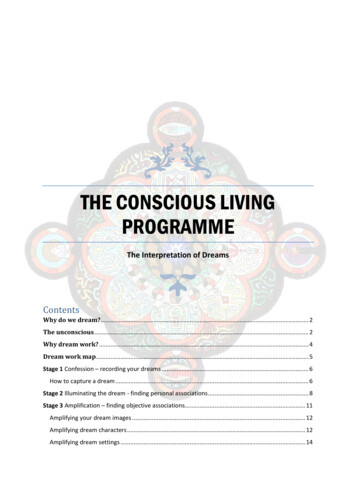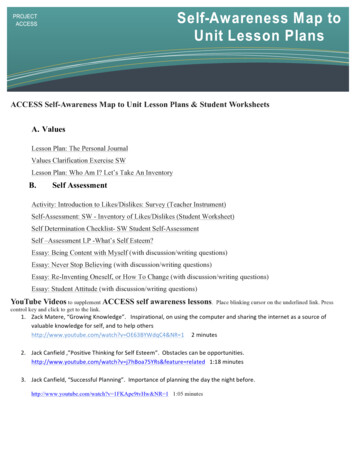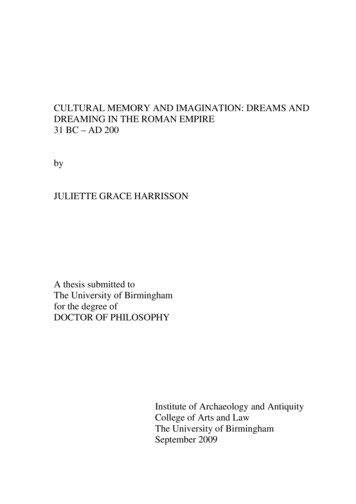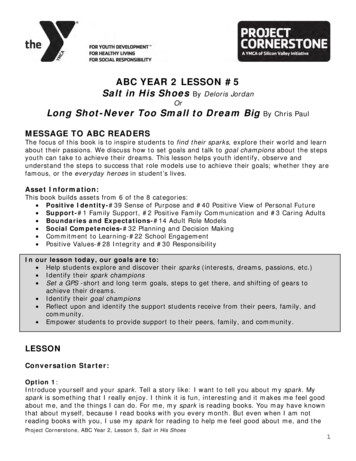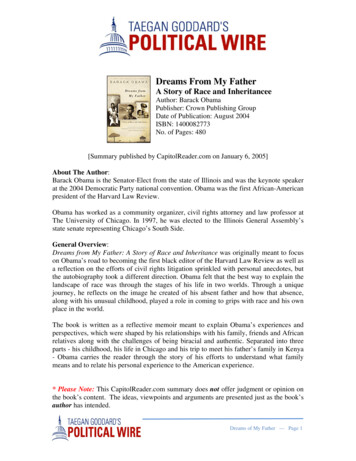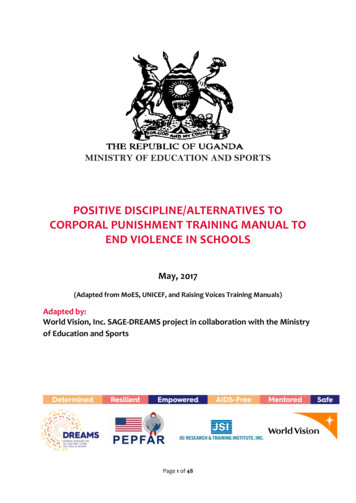
Transcription
MINISTRY OF EDUCATION AND SPORTSPOSITIVE DISCIPLINE/ALTERNATIVES TOCORPORAL PUNISHMENT TRAINING MANUAL TOEND VIOLENCE IN SCHOOLSMay, 2017(Adapted from MoES, UNICEF, and Raising Voices Training Manuals)Adapted by:World Vision, Inc. SAGE-DREAMS project in collaboration with the Ministryof Education and SportsPage 1 of 48
FOREWORDPoor quality of education services has been identified as a barrier both to children stayingin school, attending regularly and to children learning effectively. This is exacerbated byextensive use of corporal punishment and other forms of violence by teachers to disciplinestudents. Consultations with children revealed the widespread use of corporal punishmentand other forms of violence and abuse by teachers aimed to discipline students.The Government of the Republic of Uganda banned corporal punishment in 2006, butdespite this, corporal punishments continue in schools. There is a general view that inorder to eradicate harmful punishment in schools, it is vital to support and equip teacherswith knowledge and skills to promote a positive environment in the classroom thatencourages good behavior. This incorporates teaching and learning which is inclusive, childcentered and activity based, and positive discipline rather than harmful punishment.Corporal punishment is harmful and a policy which aims to eradicate it through AdvisoryNotices or Government Orders already exists. While the policy to ban is important, it isequally important to support teachers in making these bans realistic and effective.Teachers need support in managing classes through positive behavior and capacitybuilding in alternative forms of discipline. This training manual has been adopted toprovide tools and modules to assist education authorities and partners to support teachersin the making the classroom environment more child friendly and safe in order to eliminatecorporal punishment and enhance positive discipline.The intention of using positive discipline techniques is to build on available resources,experiences and knowledge. However, relevant changes in the module based on actualfacilitation experience and feedback from participants should be encouraged. Focusing onpositive techniques has been found to be more effective. Practice has shown that whilefocusing on positive techniques, participants move towards their own positive, creativestate of mind and hence the tendency to justify physical punishments begins to fade. Suchan attitude would automatically displace punishments. We hope that anybody using thistraining manual would retain this spirit.Page 2 of 48
TABLE OF CONTENTSFOREWORD . 2ABOUT THE SAGE-DREAMS PROGRAM . 5ABOUT THIS TRAINING MANUAL . 6TRAINING CONTENT . 7SESSION - I . 8SESSION – II . 9DESCRIPTION OF CORPORAL PUNISHMENT AND ITS DIFFERENT FORMS. 9SESSION – III . 10SESSION – IV . 12MYTH NO. 2: "NOTHING ELSE WORKS!" OR "THEY ASK FOR IT!" . 13MYTH NO. 4: "CORPORAL PUNISHMENT TEACHES OBEDIENCE." . 13SESSION – V . 15SESSION – VI . 18SESSION VII. 20REFERENCE MATERIALS . 21WHAT IS CORPORAL PUNISHMENT? . 21IS CORPORAL PUNISHMENT COMMON IN SCHOOLS AND HOMES? . 21WHAT ARE THE EFFECTS OF CORPORAL PUNISHMENT? . 22WHY IS CORPORAL PUNISHMENT SO COMMONLY USED AND YET ITS IMPACT ON CHILDREN IS SODEVASTATING? . 23WHY SHOULD WE EXPECT OUR SCHOOLS TO CHANGE? . 23WHAT IS THE GOVERNMENT’S POSITION ON CORPORAL PUNISHMENT? . 24SAMPLE OF NATIONAL POLICY THAT SUPPORTS UGANDA’S POLICY AGAINST CORPORALPUNISHMENT IN SCHOOLS . 24SAMPLE OF REGIONAL POLICY THAT SUPPORTS UGANDA’S POLICY AGAINST CORPORALPUNISHMENT IN SCHOOLS . 25INTERNATIONAL AGREEMENTS WITH UGANDA’S LEGAL COMMITMENT . 26ALTERNATIVES TO CORPORAL PUNISHMENT: POSITIVE DISCIPLINE WITHIN SAFER SCHOOLS . 27WHY DO CHILDREN BEHAVE AS THEY DO? . 27WHAT IS POSITIVE DISCIPLINE? . 28ALTERNATIVES TO CORPORAL PUNISHMENT . 28WHY SHOULD WE USE A POSITIVE DISCIPLINE APPROACH IN OUR SCHOOLS? . 29HOW DOES POSITIVE DISCIPLINE CREATE SUCCESSFUL INDIVIDUALS? . 29HOW DOES POSITIVE DISCIPLINE LEAD TO BETTER SCHOOLS? . 30WHY A SAFE AND VIOLENCE FREE SCHOOL? . 30VIOLENCE FREE AND SAFE SCHOOLS LEAD TO BETTER LEARNING AND HEALTHIER CHILDREN . 31WHY SHOULD WE CREATE VIOLENCE FREE AND SAFE SCHOOLS? . 32WHOSE RESPONSIBILITY IS IT TO CREATE SAFE AND VIOLENCE FREE SCHOOLS? . 33REFLECTION QUESTIONS . 33REFECTION GUIDE . 34HOW DO I KNOW IF I AM USING POSITIVE DISCIPLINE? . 37HOW DO I RESPOND TO MISBEHAVIOR USING POSITIVE DISCIPLINE? . 39HOW DO I CREATE A POSITIVE CLASSROOM ENVIRONMENT? . 41WHAT ARE SOME EXAMPLES OF POSITIVE DISCIPLINE IN ACTION? . 43CONCLUSION . 48Page 3 of 48
INTRODUCTIONThe Government of the Republic of Uganda (GOU) is committed to promoting children’sfundamental right to obtain quality education in a conducive and safe learningenvironment that is free from violence.1 Despite this commitment, four major studies onthe experiences of violence conducted in Uganda revealed that corporal punishment,physical violence, emotional/psychological abuse and sexual violence/abuse is widespreadand affects both boys and girls. Child negligence in homes renders children, especiallythose from poor family backgrounds, orphans and those in alternative care morevulnerable to violence in schools. Children in Ugandan schools experience various formsof abuse from teachers and other staff, parents, fellow learners and other adults. Childrenwith special needs are often labeled as “unintelligent” by their teachers and fellowchildren, resulting in poor self-esteem and self-image that contribute to them droppingout of school.Violence in schools undermines children’s security and safety, and inflicts physical,psychological and emotional pain and fear among boys and girls. It is associated withprofound physical, psychological and emotional consequences. Violence undermines thechild’s self-esteem damaging her or his potential to take advantage of existing learningopportunities. School-related Gender-based is a violation of children’s right to education,protection and development, and a threat to children’s retention and performance inschools.Findings from a study (MoESTS and UNICEF, 2013) in eight districts involving 30 primaryschools and 10 secondary schools showed that 74.3% of all surveyed children experiencedphysical violence at school at the hands of a teacher; whereas in 30% of the cases ofphysical violence were perpetrated by fellow students. Sexual violence at school wasreported by 77.7% of all surveyed primary school children and 82% of secondary schoolstudents. 67% identified male teachers as the perpetrators of sexual violence in schools. Inthe study, 46% of surveyed children reported emotional abuse, which was more commonin primary schools (56%) than in secondary school (41%). In both cases, respondentsidentified teachers as perpetrators about half the time. About 43% of respondentsreported bullying in school (46% in primary and 31% in secondary).2The ANPPCAN 2011 Annual Report including 990 primary school students in five districtsfound that 81.5% of surveyed children reported physical violence, 24% reported verbalsexual harassment (of these 63% were girls), and 25% reported being touched/fondled withgirls outnumbering boy victims in a pattern similar to verbal harassment (66% and 34%,respectively) and 8% of children reported forced sex. Interviews revealed that someteachers, following the Bannon corporal punishment approach, resorted to emotionalviolence to maintain classroom control.31The National Strategic Plan on Violence Against Children In Schools, 2015-2020; page 9Please see: Uganda Ministry of Education, Science, Technology, and Sports (MoESTS) & United Nations Children’s Fund (UNICEF).2013. Research briefing: Assessing child protection, safety, and security issues for children in Ugandan primary and secondary schools.Kampala, Uganda: MoESTS and UNICEF. Available at: http://www.unicef.org/uganda/VACis Study Summary July 8th 10.31am(1).pdf3 In terms of perpetration: In the study, 57% of the children reported experienced Bullying and Threat while at school. 73% of allphysical violence was reported to be perpetrated by teachers and 15% by fellow students, while fellow children (32%) were the mainperpetrators of verbal sexual harassment followed by teachers (12%). Being touched/fondled was reported to be perpetrated by otherchildren, with only 5% reporting fondling from teachers. However, teachers made up of 26% of the perpetrators of forced sex. 62% ofsurveyed children cited fellow students as the perpetrators of bullying followed by teachers. For more information, please see:African Network for the Prevention and Protection against Child Abuse and Neglect (ANPPCAN) Uganda. 2011. Baseline Survey to2Page 4 of 48
A 2005 Naker study conducted with 1,000 Ugandan children participants ages 8–18, bothin and out of school, in five districts across the country found that 28.6% of the surveyedchildren experienced physical violence mainly at school, 24.3% reported experiences ofsexual violence at school. Children in school were also more likely to report being forcedto kiss on the mouth, experiencing unwanted sexual exposure, forced to touch someone,and forced to have sex, compared to children out of school, and 21.2% of children surveyedexperienced emotional violence at school. This may possibly reflect the use of coerced sexto obtain school fees or better grades.4Various interventions exist to address the problem of corporal punishment in schools. Keyones include: creating a safer school, the revised circular Teachers’ Code of Conduct.5However, there are many barriers to their effective implementation. Creating safer schoolsas an alternative to corporal punishment lacks effective methodology to deliver it. TheSAGE-DREAMS team developed a teacher training manual to address this challenge.ABOUT THE SAGE-DREAMS PROGRAMOVERVIEWDespite Uganda’s success in combating HIV/AIDS, new HIV infections among adolescentgirls and young women aged 15-24 are on the rise. Young women are reporting increasedcases of sexually transmitted infections and gender-based violence. The DREAMSInnovation Challenge funded by the U.S. President's Emergency Plan for AIDS Relief(PEPFAR); Janssen Pharmaceutica NV (Janssen), one of the Janssen pharmaceuticalcompanies of Johnson & Johnson; and ViiV Healthcare – is an ambitious partnership toreduce new HIV infections among adolescent girls and young women.The goal of DREAMS is to help girls develop into Determined, Resilient, Empowered AIDSfree, Mentored, and Safe women. The underlying principle of the Strengthening School –Community Accountability for Girls Education (SAGE) project is that girls can and often doreach their full potential when they are retained in school, have access to Youth FriendlyReproductive Services, are supported by parents, teachers and their communities; thenthey perceive themselves as both capable and resilient. SAGE-DREAMS will increaseawareness on HIV prevention and engage the larger community in support of girls toachieve their hopes and aspirations using adolescent peer-led and stay in schoolcommunity approaches.Assess Violence against Children in Arua, Apac, Kitgum, Mukono, and Rakai Districts. Uganda: APPCAN. Available earch reports/Violence Against Children in schools 2011.pdf4 In terms of perpetration: Respondents reported adults as the main perpetrators of sexual violence in schools, but many school-girlsalso reported pressure from older male students in addition to teachers. At schools, teachers and older students were named as theperpetrators of emotional violence. The study found also that many older boys felt teachers were more likely to humiliate them,competing with them for older girls’ attention. Teachers might also have feared retaliation if they used physical violence against olderboys and so resorted to emotional violence. For more information, please see: Naker, D. 2005. Violence against children: The voices ofUgandan children and adults. Kampala, Uganda: Raising Voices and Save the Children. Available at: /downloads/resources/violence against children.pdf5http://moe.edu.tt/general pdfs/National Schools Code of Conduct.pdfPage 5 of 48
The existing negative cultural norms and gender-based violence especially early marriagesand early pregnancies expose adolescent girls to HIV infection that contributes todropping out of school. However, if the capacity of these adolescent girls is enhanced toovercome the various challenges they face, their potential to foster an AIDS-free futurewill be improved.EXPECTED RESULTSOver the next two years, SAGE-DREAMS will reach 45,000 adolescent girls throughestablishment of functional Peer-led Early Warning Systems (EWS), Stay in SchoolCommittees (SISC), Safe School Contracts and Safety Friends to achieve reduced new HIVinfection rates and retention.The project is expected to contribute to: Improved adolescent girls’ health seekingbehaviors and delayed sexual debut; prevention of school dropout, reduced violence andnew HIV infection; adherence to anti-retroviral therapy; positive attitudes towards peopleliving with HIV and reduced.KEY INTERVENTIONSKey interventions for SAGE-DREAMS include: life skills training, community dialogue,outreaches, awareness raising on HIV/AIDS prevention, mentorship, coaching, and on-sitesupport. These activities will engage adolescents through their peers, school andcommunity stakeholders, health service providers, faith leaders, parents/care givers,school administrators, teachers, law enforcement personnel, district leaders, governmentofficials and other implementing partners for meaningful involvement and expertise.ABOUT THIS TRAINING MANUALThe positive discipline manual is designed for teachers and other stakeholders engagedwith learners to end violence against children in schools. It aims at equipping them withskills and information to alternative forms of discipline to corporal punishment to endviolence against children.This manual is adopted from the safer schools; alternative to corporal punishmenthandbook. It introduces innovative methodologies to deliver content in a moreparticipatory manner. It draws from the existing content. The training manual consist ofthe following: Definitions of corporal punishment Myths and facts about corporal punishment Research finding on causes and magnitude of the problem of corporal punishment International and national legal frameworks that address corporal punishment GOU efforts so far and persistence of corporal punishment in schools despite thedevastating negative effects on learners.The content also covers alternatives to corporal punishment sometimes referred to aspositive discipline as a better way of helping learners develop into confident andresponsible citizens of Uganda.This training will be delivered in a two-day workshop by trained facilitators.Page 6 of 48
TRAINING GOALTo create safer to contribute to the SAGE-DREAMS project goalOBJECTIVESBy the end of the program, participants will be able to: Identify what constitutes corporal punishment in schools, its effects on learners, legalframeworks and the need to change the social norms and practices from corporalpunishment to alternatives that promote positive discipline. To help teachers and other stakeholders embrace their roles as protectors of childrenand agents of change in preventing violence against children. To adopt alternative strategies to corporal punishment.EXPECTED OUTCOMESThis training program is intended to: Build the capacity of teachers to fully explore the advantages of positive discipline,non-violent attitudes and behaviors in classrooms - a reward that ultimately benefitseach of them individually, their classrooms, schools, communities and the society atlarge. Promote a safer school learning environment, children’s retention and participation inschools.TRAINING CONTENTDURATION OF THE TRAINING The duration of the orientation is usually 1 to 2 days depending on the size of the team,and the background of the participants in the team and the facilitator's ability tochannel the discussions. By background we refer to participants' extent of familiaritywith each other, the team, and their prior work experience with children because thedepth of interactions is dependent on these factors. A few participants may be already self-critiquing whether they are doing the right thingby punishing the children. Once such participants feel assured that they would not bejudged, they begin to voice their inner conflict pertaining to physical punishments.Such sharing should lead to discussions and debates. The success of the orientation is in facilitating a healthy debate towards a thinkingprocess rather than providing quick-fix solutions. It is important to ensure that nobodyfeels ‘Judged’ or ‘Misjudged’ for being honest with their beliefs about punishments.However, it is equally important to drive home the message that it is inappropriate tophysically and verbally abuse children.Page 7 of 48
SESSION - ICLIMATE SETTING SESSIONIntroductionObjectiveActivityThis session helps participants to learn more about one another andto establish trust while providing an overview and the goal of thetraining program. It will give them an opportunity to express theirachievements in regard to children education.This session allows participants to know each other and set theclimate for delivery.Introduction; self-reflection; setting workshop goals, ground rules,expectations and fearsFlip chart, sticky notes, markers and markersGroup work45 minutesMaterialsMethodologyTimeFacilitator’s GuideIntroduce the session, objectives, and duration.Instructions1. Identify a volunteer to write down the points and another volunteer to present thegroup's points2. Ask participants to introduce themselves by mentioning their names, and the schoolor institution they belong to.3. Ask participants to share their achievements as teachers towards the cause ofchildren’s education.4. Ask participants to write one expectation and fear on a sticky note and post them ondesignated flip chart.5. Ask them to choose an interesting name for their group6. Ask participants to brainstorm on ground rules which are written on a flipchartPage 8 of 48
SESSION – IIDESCRIPTION OF CORPORAL PUNISHMENT AND ITS DIFFERENT FORMSIntroductionObjectiveIn this session, participants will have a broader understanding ofcorporal punishment and its different formsBy the end of the session, participants will be able to: Describe the meaning of corporal punishment, its forms andeffects on learners Have a shared understanding of corporal punishmentInteractive presentation or groupFlip charts and markersCatch me out game45 ’s GuideIntroduce the session, objectives, and duration.Instructions1. Invite participants to engage in catch me out game where participants actively dowhat the facilitator is doing. Participants who fail to do what the facilitator is doingwill be punished using information on the sticky notes.2. There is an observer standing in front of the class to identify any one who fails todo as requested.3. Different forms of punishment will be written on sticky notes and given toparticipants at random.4. When a participant is caught in the act! The ones with the sticky notes will comeand administer the punishment written on the sticky notes.5. The game is repeated until a winner is found. The winner is rewarded. However ifall participants fail the game, then all are punished and the game comes to an end.Activity: Catch Me OutPage 9 of 48
SESSION – IIIEFFECTS OF CORPORAL PUNISHMENT ON LEARNERS, TEACHERS ANDPARENTSIntroductionObjectiveIn this session, participants will use their experiences and explorethe effects of corporal punishment on learners, teachers andparents.By the end of the session, participants will be able to: Describe the effects of corporal punishmentGroup workFlip charts, markers and masking tape, cards cut from manila paperPair and share, group work and brain storming01 hour 10 ’s GuideIntroduce the session, objectives, and duration.Activity 1: Pair and ShareTime: 20 minutes1. Explain to the participants that all people desire to discipline their childrenproperly. This exercise will enable us reflect upon the disciplining strategiesthat were used while we were still in school.2. Ask participants to pair up and share their personal experience when theywere disciplined using corporal punishment (let them discuss how it madethem feel and whether it forced them to change)3. Ask 4 to 5 people to share with the larger group (be sensitive about thegender)4. Conclude by saying that all of us at one time have been punished through useof corporal punishment. We have different experiences that we will continueto explore.Activity 2: Group WorkTime: 30 minutes1. Ask participants to form 3 groups. In each group, they identify a teacher/parent ora child and reflect on how they felt when they were in school and share theirexperiences of corporal punishments.2. In each group, one person should be a teacher, the other a parent and another onea child.3. Tell participants in their different roles to only describe their feelings aboutcorporal punishments they received at school.4. Ask the following questions:o As a parent or a teacher, what did you feel after giving corporal punishment toa child?o As a child, what did you feel after getting a corporal punishment?5. Ask participants to put up their cards on the same flip chart or wall.6. Ask a volunteer from each group to read out what is written on the cardsPage 10 of 48
7. Summarize the discussions on corporal punishment by reminding the participantsabout the negative effects of corporal punishments on learners.8. Give out resource materials on the topic to enable participants to read and remindthemselves of the effects of corporal punishments.Activity 3: Harmful Nature of Corporal Punishment on LearnersTime: 20 minutes1. Ask each participant to write the effects of corporal punishment on a sticky noteand place it on a flip chart on the wall.2. When participants have completed posting their ideas, the facilitator should putforth this questions: Is there any use in resorting to a practice which causes more harms thanbenefits?" What should we do to stop corporal punishments in our schools andcommunities? Notes down the responses for these questions on a flip chart and places iton the wall for reference. Summarize the session by emphasizes the need to end corporalpunishments given the harms it causes to the learners, parents and children.Page 11 of 48
SESSION – IVCHALLENGING WIDELY ACCEPTED BELIEF THAT CORPORAL PUNISHMENT ISESSENTIAL TO DISCIPLINE AND HELP CHILDREN TO LEARNObjectiveActivityMaterialsBy the end of the session, participants will be able to: Challenge the widely accepted belief that corporal punishment isessential to discipline and help children learnInteractive presentation and discussionsPrepared flip charts containing the following points, copies of thesheet containing myths and realities20 minutesTimeFacilitator’s GuideIntroduce the session, objectives, and duration.1. Emphasize that in the previous activity, participants shared their experiences oncorporal punishment and its effects but now let us explore whether these beliefs arejustifiable2. Ask participants to form 3 to 4 groups where they come up with role plays on thefollowing:o It happened to me and did no harmo Corporal punishment teaches obedienceo Corporal punishment is part of our cultureo It is the only way I can control the children in my class. I have too many.3. Ask participants present in plenary4. Invite 4 participants to comment on the different role plays5. Challenge the myths and explain that corporal punishment brings temporally results.Echo that these are myths and not facts of life. It negatively impacts someone’sbehavior, character, relationships and the person disciplining.6. Provide a copy to participants about the myths and facts on corporal punishment.Myths and Realities6Facilitator should do the following: Raises each statement, and then discuss why it is a myth and not a fact. Distribute copies at the end of the session.Myth No. 1: "It happened to me and did me no harm."Fact: Though they may have felt fear, anger, and mistrust from being hit by parents orteachers, people who use this argument often do it to reduce the guilt they have for usingcorporal punishment on their children today. In their minds, they are defending theirviolent actions against their children. However, their actions reveal that corporalpunishment did, in fact, do them harm: it perpetuated the cycle of violence that they nowinflict upon children, and similarly these children are more likely to perpetuate theviolence for generations to come.6UNESCO PUBLICATION (Toolkit for Creating Inclusive, Learning-Friendly Environments)Page 12 of 48
Myth No. 2: "Nothing else works!" or "They ask for it!"Fact: The problem is the disciplinary approach, not the misbehavior of the children.Justifying that a child has asked for violence is really intended to make the perpetratorfeel less guilty and transfer the blame to the victim. Besides, do you normally hit yourboss, employee, spouse, or best friend when it appears that "nothing else works"?Hopefully not!Myth No. 3: "Corporal punishment works best. Other methods don't."Fact: Corporal punishment creates a sense of distrust and insecurity in the child, itdestroys the teacher-child relationship. Children become angry at why someone who issupposed to teach and care for them is instead threatening, beating, or insulting them.While a single act of corporal punishment may seem to be effective, it only temporarilyfrightens a child into submission.Myth No. 4: "Corporal punishment teaches obedience."Fact: In the past, the practice was to teach children to obey authority withoutquestioning. Now teachers adopt child-centered learning techniques to encouragechildr
physical violence at school at the hands of a teacher; whereas in 30% of the cases of physical violence were perpetrated by fellow students. Sexual violence at school was reported by 77.7% of all surveyed primary school children and 82% of secondary school students. 67% identified male teachers as the perpetrators of sexual violence in schools. In
